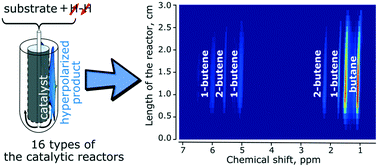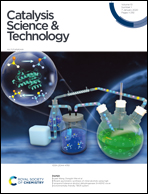Spatially resolved NMR spectroscopy of heterogeneous gas phase hydrogenation of 1,3-butadiene with parahydrogen†
Abstract
Magnetic resonance-based methods such as nuclear magnetic resonance (NMR) and magnetic resonance imaging (MRI) are widely used to provide in situ/operando information of chemical reactions. However, the low spin density and magnetic field inhomogeneities associated with heterogeneous catalytic systems containing gaseous reactants complicate such studies. Hyperpolarization techniques, in particular parahydrogen-induced polarization (PHIP), increase significantly the NMR signal intensity. In this study, we test 16 glass tube reactors containing Pd, Pt, Rh or Ir nanoparticles dispersed on a thin layer of TiO2, CeO2, SiO2 or Al2O3 for the hydrogenation of 1,3-butadiene using parahydrogen. The catalytic coatings of Ir and Rh gave hydrogenation products with the highest nuclear spin polarization while the coatings of Pd are the most selective ones for the semihydrogenation of 1,3-butadiene to 1- and 2-butenes. Spatially resolved NMR spectroscopy of the reagent and the product distribution along the reactor axis provided further mechanistic insight into the catalytic function of these reactive coatings under operando conditions.



 Please wait while we load your content...
Please wait while we load your content...